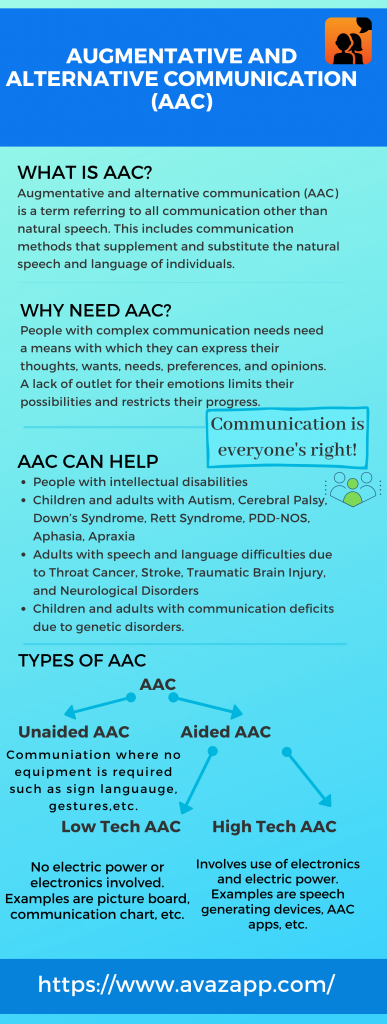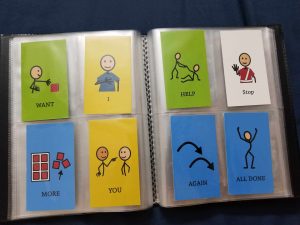What is AAC(Augmentative and Alternative Communication)? : A Detailed View
 AAC has proven to have positive effects on people with communication deficits. What is AAC? And how can it help people with communication and language difficulties? Read on to find out more:
AAC has proven to have positive effects on people with communication deficits. What is AAC? And how can it help people with communication and language difficulties? Read on to find out more:
Augmentative and alternative communication (AAC) is a term referring to all communication other than natural speech. This includes communication methods that supplement and substitute the natural speech and language of individuals. For people with communication challenges and comprehension difficulties, AAC devices are a way to express their feelings, opinions, needs, and wants.
Communication is complex in nature and involves more than one form of expression. We regularly use gestures, body language, and facial expressions, in addition to written and spoken language, to effectively convey our intent. AAC is one such mode of communication that allows people with language and speech difficulties to make themselves understood.
The Need for AAC
As a society, we take communication for granted. Speech and language problems can affect an individual’s quality of life because they restrict communication. The lack of an outlet for feelings and thoughts can lead to frustration, disillusionment, and behavioural problems. This, in turn, can affect the standard of support they receive from their families and caretakers.
Here are some of the ways speech and language impairments affect individuals:
- People with speech difficulties are not able to make themselves heard.
- Mingling with friends or attending regular school becomes tough. Their inability to mix with peers leads to poor self-esteem and a life of exclusion and loneliness.
- Their preferences are often taken for granted and intentions are second-guessed. People’s expectations of them are generally lower, for no fault of theirs.
- This leads to poor self-esteem and confidence. This further prevents the individual from leading an inclusive, fulfilling life and reaching their potential.
For non-verbal individuals, a means to communicate empowers them to lead a life of equality and dignity. AAC strategies and devices serve as an excellent tool to resolve communication issues.
Who can Benefit from AAC?
AAC can help anyone with communication deficits. The communication challenges may be present in early childhood or may have developed later in life due to neurological and other conditions. Such communication problems must be addressed immediately. Delays in intervention can cause anxiety, annoyance, and exasperation in addition to deep-rooted behaviour issues. Many people can benefit from AAC, including (and not restricted to):
- Children and adults with speech and intellectual disabilities – non-verbal, partially verbal and single word communicators.
- Children and adults with Autism, Cerebral Palsy, Down’s Syndrome, Rett Syndrome, PDD-NOS, Aphasia, Apraxia or any other condition that affects speech.
- Adults with speech difficulties due to Throat Cancer, Stroke, Traumatic Brain Injury, and Neurological Disorders
- Children with delayed development indicators
- Other genetic disorders that affect speech
How Does AAC help?
The primary function of AAC is to enable the user to be understood. For nonverbal users, it can mean a way to replace speech. For those who are minimally verbal, it is a supplemental method to improve their comprehension.
AAC acts as a communication bridge. It connects users to their support system, which includes their families, friends, therapists, and Speech and Language Professionals (SLP). It helps the user foster functional relationships. It also offers them the confidence to be a valuable member of society. The broader societal benefit of enabling children with speech difficulties to “speak for themselves” is a step towards a more inclusive society. This leads to equal educational and economic opportunities for them. The benefits of AAC include:
- Gives the ability to communicate
- Reduces anxiety
- Reduces tantrums and behavior issues
- Increases independence
- Boosts self-confidence, self-esteem
- Provides access to education by helping class participation and academic progress
- Improves attention
- Provides access to equal opportunities at education and work
- Empowers the individual and helps achieve one’s goals
- Improves social relationships
- Improves overall Quality of Life by living a life with Dignity and Inclusion
Types of AAC
No conversation about AAC can be complete without a discussion about the different kinds of AAC. AAC can be broadly categorized into aided and unaided systems-
Unaided AAC
No equipment is involved in unaided AAC. Communication generally happens through sign language, vocalizations, gestures, body language, and facial expressions.
Aided AAC
Aided AAC is where the user communicates using external tools. The tools can be further classified into low-tech and high-tech AAC.
Low Tech AAC
The use of simple tools such as a picture board falls under the low-tech category. These tools do not require electric power or electronic components for their functioning. The user’s method of conveying a message through the communication boards or books largely depends on their motor skills and physical abilities.
The user selects appropriate phrases, pictures, letters, words, and symbols listed on the communication boards to construct their message. The user selects using a body part, eye-gaze direction, pointer, or a head/mouth stick. In some cases, the user also communicates by answering Yes or No questions as a caretaker goes through the options on the board.You can download Avaz’s low tech communication boards here.
- High Tech AAC
High Tech AAC comprises of strategies involving the use of electronics and other technologies. This includes computers, speech-generating devices, and tablets. A communication app for iPad or Android with pictures and text is an example of high-tech AAC.
Children in need of AAC can benefit from high-tech solutions because it might be easier for them to learn to use. Users can effortlessly make several customizations in AAC devices. This encourages consistent use, resulting in a tremendous improvement in their communication skills. Personalization of the apps where the user can add images and voices according to their preference also motivates them to use the app for their social interactions.
Do you have any information to add regarding what is AAC(Augmentative and alternative communication)? Please share your ideas in the comment section below!!
AAC acts as a communication bridge. It connects users to their support system, which includes their families, friends, therapists, and Speech and Language Professionals (SLP).
Subscribe to the Avaz Newsletter
Join 4000+ fellow readers! Get latest articles straight to your inbox. Enter your email address below:
Popular Articles
- Building Literacy: Teaching Grammar to AAC Users
- Expansion of Language: Supporting AAC Learner’s Progress
- Avaz User Stories and Videos
- Avaz Joyful Reading: Resources for Shared Reading
- AAC Resources: Games, Activities and Communication Opportunities
- Avaz AAC User Stories: Why Nishant and his AAC System are Inseparable
- Downloadable Low Tech Communication Boards
- Get the Better of Reading Difficulties with MDA Avaz Reader
- AAC Apps for Adults with Acquired Communication Disorders
- Teletherapy: A smart way to facilitate remote speech therapy for adults and children


